The best tips for your trip to Takayama, Japan
Atualizado em:
Takayama is located in the Gifu Prefecture, in the mountainous region of Hida. Because it is in a region that is more isolated and difficult to reach, Takayama has preserved its architecture and some traditions of its own. The highlight of the city is the super charming historic center dating from the Edo period (1600-1868) which today houses several interesting little shops; the sake distilleries where you can enjoy tastings, and the Takayama Matsuri, a festival that is always held for two days at two times of the year, one in the spring and one in the fall, during which the city is in full swing. Prepare your coat as it’s colder here than in other regions of the main island of Japan, and come travel with me on these Takayama tips!
If you want, click on the item below and go straight to the point where I talk about:
-How to get to Takayama?
-How long to stay in Takayama?
-Where to stay in Takayama?
-Where to eat in Takayama? And what to eat?
-Things to do in Takayama
-Our two-day itinerary in Takayama
Read more: Practical and essential tips for planning your trip to Japan
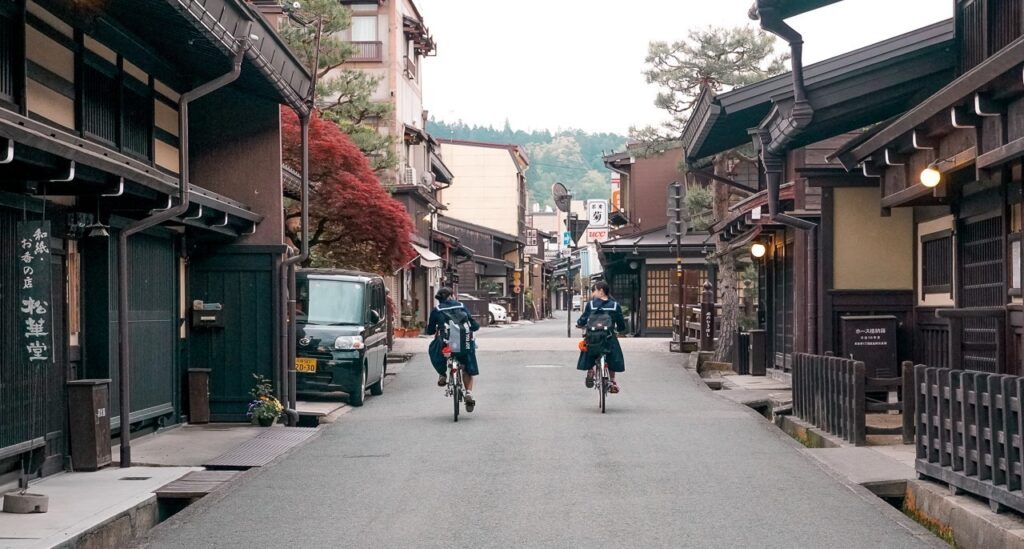
Students return home by bike in the afternoon in Takayama, a very traditional city in Japan
How to get to Takayama?
The most practical way for tourists to travel in Japan is by train, which covers the entire length of the country and is very fast and punctual. Arriving in Takayama is even more convenient for those in possession of the JR Pass, the train pass which is super practical for tourists and must be purchased before your arrival in Japan.
To get to Takayama by train from Tokyo using the JR Pass, it’s almost a 4-hour trip: 1 hour and 20 minutes by shinkansen (bullet train) to Nagoya, a brief connection, and then another 2 and a half hours by a local train to Takayama itself, with beautiful views across the mountains. Those coming from Kyoto take the same route: half an hour by the shinkansen train to Nagoya, and then 2.5 hours with the local train to Takayama.
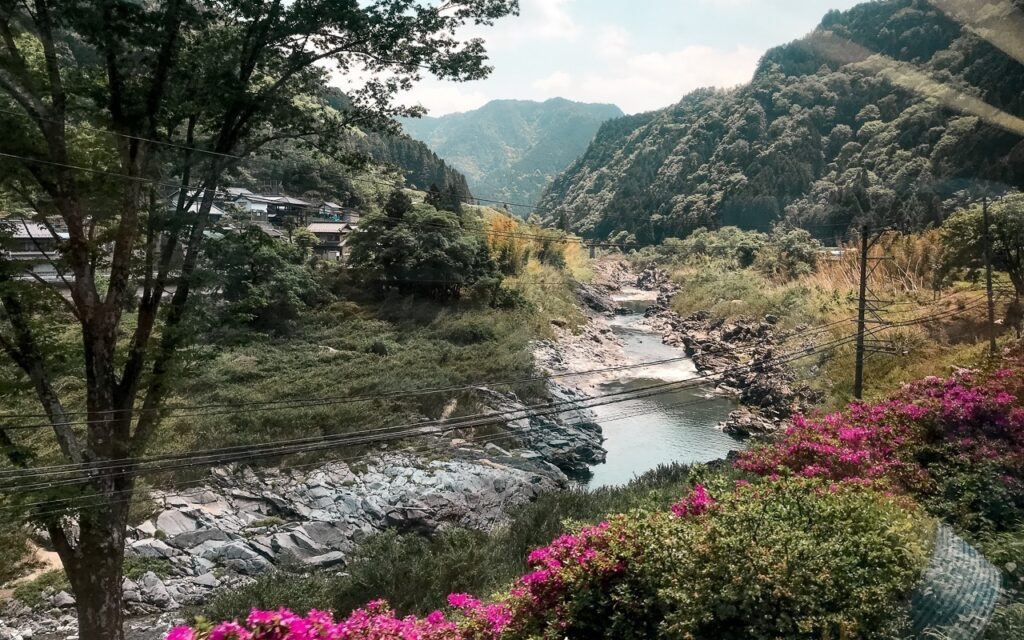
Arriving and departing Takayama by train allows you to go through some scenic landscapes of Japan’s inland
For those departing from Kanazawa, the quickest and easiest way is to take a 20-minute shinkansen ride from to Toyama, then take the local train for 1.5 hours to Takayama.
How long to stay in Takayama?
Takayama is a very small city, it was the smallest city in Japan that we spent the night in during our trip. It’s easy to explore the main points of interest in a single day, but make sure you are there from 10 am to 5 pm, as it’s when the city is livelier and the shops and attractions are open.
We spent two nights in Takayama because we wanted to visit Shirakawa-go village on a day trip (this is another tour that you have to do from 9 am to 4 pm; any time after that and the village is deserted). We think two nights was just the right amount.
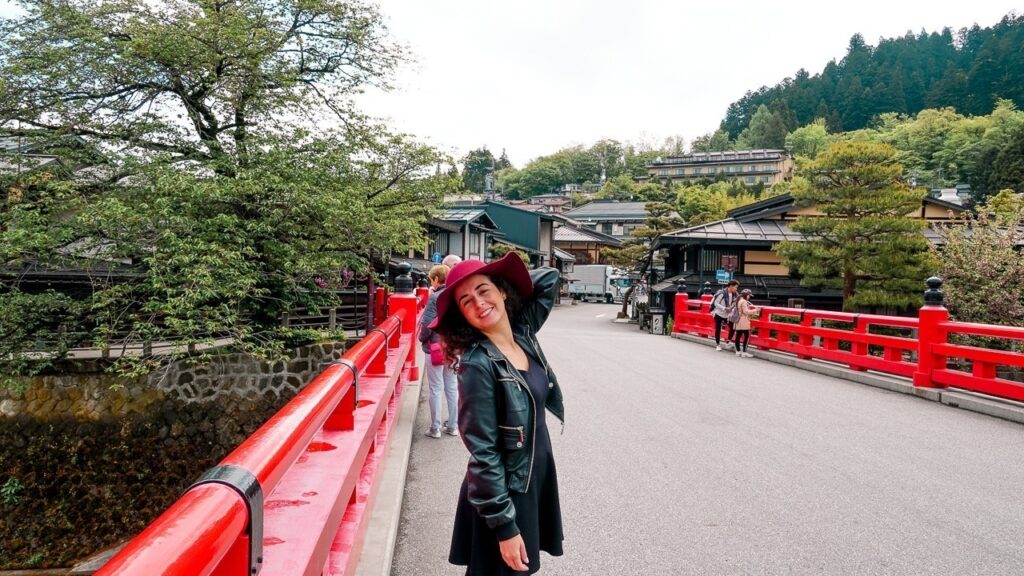
Two nights were enough to get to know Takayama and Shirakawa-go.
If you don’t want to visit Shirakawa-go, one night is enough. Three nights seems too long for Takayama, and I would only recommend this if you were to spend the third night at a ryokan (traditional Japanese inn) in the mountains to have time to relax, meditate and enjoy it with no rush. Or if you travel at the time of the Takayama Matsuri, one of the best-known festivals in the country.
Read more: How much does it cost to travel to Japan? Real expenses from my trip
PS: I think it’s totally possible to stay in a ryokan in downtown Takayama without having to add an extra night in the city. See the recommendations for where to stay in Takayama below:
Where to stay in Takayama?
As I said earlier, Takayama is a teeny-tiny town. If you choose to stay in the city itself, you’ll be within 15 or 20 minutes walking distance of the main points, at MAX. There are also some lodging options in the middle of the mountains in small villages that surround the region and further away from the main points of interest. It seems to me a bucolic and charming option, but little practical for those with only a few days of travel. It may even be a good idea for those who want to spend an extra night in a remote ryokan amidst the mountains, or for those who go during the Winter and wanna go skiing.
Ryokans in Takayama: for those who want to stay in a ryokan in downtown Takayama, our tip is the Ryokan Tanabe. I passed by it and took a peek inside, and found it super authentic. Also, the location is great and the reviews are wonderful. Another great ryokan option in Takayama is the Oyado Koto No Yume or the cute Ryokan Asunaro.
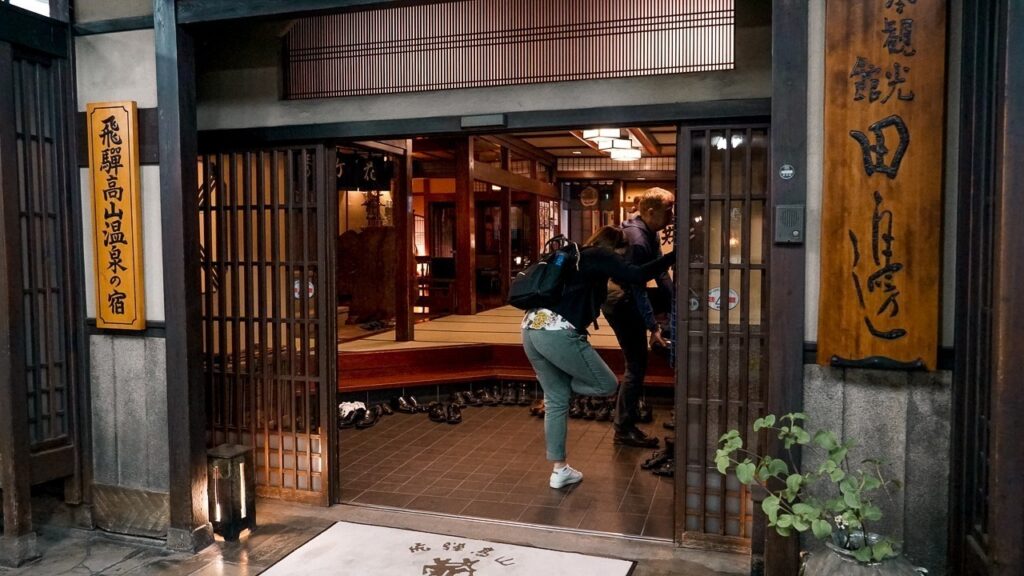
Ryokan Tanabe, a great choice for a traditional Japanese inn in Takayama
Hotels in Takayama: if you’re already going to experience a ryokan elsewhere in Japan, or prefer to stay in a much more westernized hotel, the tip is the Best Western Takayama which is real close to the station and on the way to the city center. Or the Wat Hotel & Spa which has onsens and rooms that, from the standard category, are really tidy and with good options for families.
Neither ryokan, neither hotel. Where I stayed in Takayama: In Takayama, I stayed at the Takayama Ouan, a hybrid between a western hotel and a traditional ryokan (believe me, this fusion exists). It was a great starter, as we had to take our shoes off before entering the hotel grounds, the breakfast had Japanese options and some western food options, and the best: it had a rooftop onsen for guests!
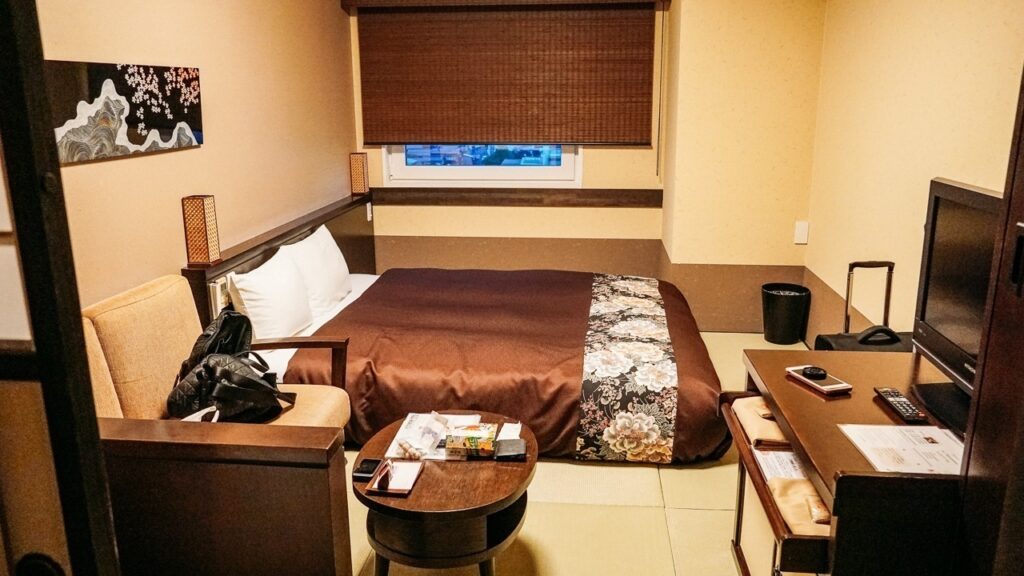
Takayama Ouan, our choice of lodging in Takayama. Our first room was smaller than the booking photo referring to the category we booked, so we asked to switch to a larger one and moved to this one.
Onsens are the Japanese hot springs, and bathing in these waters are very common practices when you want to relax and regain your energy (it’s delicious and hyper relaxing!). At the rooftop of the Takayama Ouan, you can bath in a private onsen or the public one. During the trip this was my only opportunity to know what a public onsen is like in Japan, and I found it very interesting the habits and practices you have to follow before getting in the waters (eg. you have to wash yourself wholly before in one of the queued showers, but you do it sitting on a stool so as not to disturb people nearby… oh, and you also get in the water completely naked).
It wasn’t until the second day that I visited the hotel’s onsen that I got why the room showers were so small: because it’s upstairs that you have to bathe! In the room there’s a little basket with towels, you take this basket up and go already dressed in this outfit from the photo below, which is used to circulate inside the hotel. Then you take your hot bath in the springs, dry yourself and go back to your room to get ready. Awesome, I wish I’d done it every day! Oh, and the Wat Hotel & Spa also has onsen on its premises.
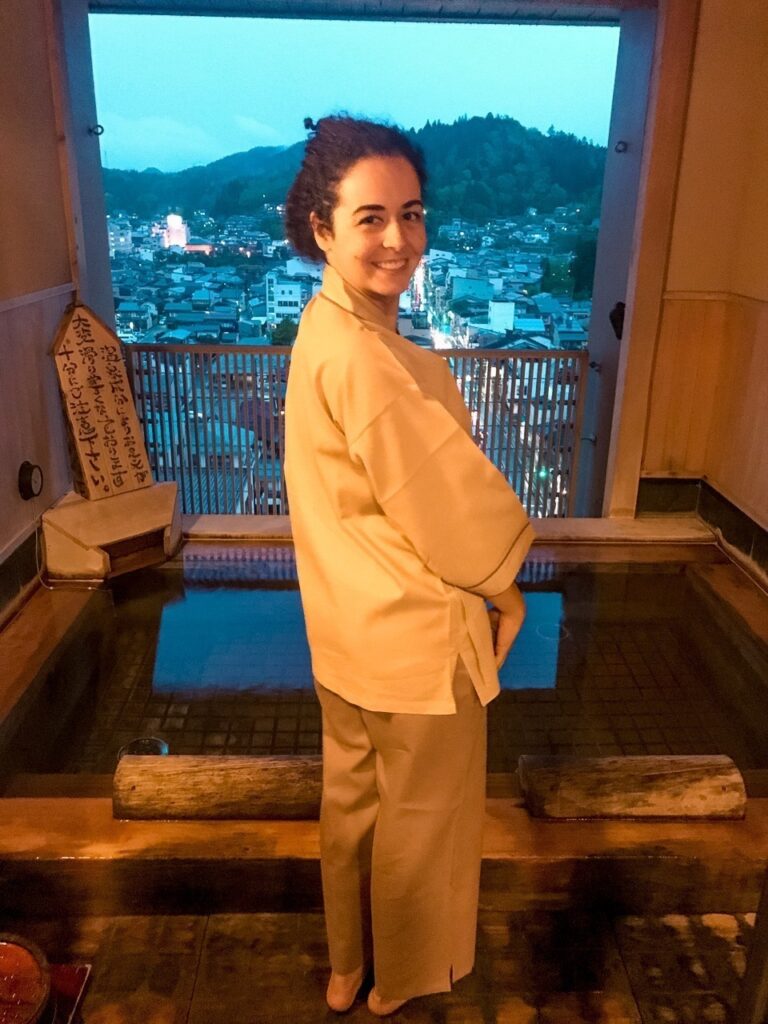
Private rooftop onsen with a view to the city and the mountain at the rooftop of Takayama Ouan hotel
Blog tip: it’s always good to book hotels in advance, especially during the fall and spring in Japan, when it’s high season. If you are visiting Takayama during the Takayama Matsuri then, make sure you rush to book your lodging and train tickets to and from the city, as everything gets crowded!
Have fun: 10 different things you only find in Japan
Where to eat in Takayama? And what to eat?
One of the most delicious things about Takayama is eating the street food of the city. You’ll see several stalls between the shops and you can enjoy the market that gathers on the Miyagawa River in the mornings (until noon or so). Take this opportunity to enjoy Mitarashi Dango, a skewered rice ball that is grilled and served with a tasty sauce, the ice creams and sweets, and Hida Beef skewers.
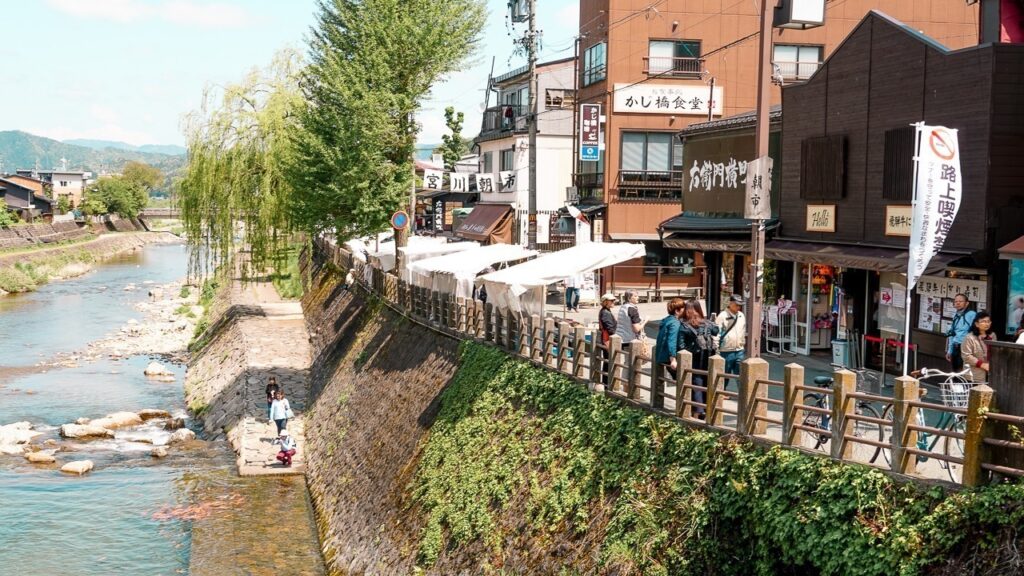
Riverside street market in Takayama. Note the carp in the water on the lower-left corner!
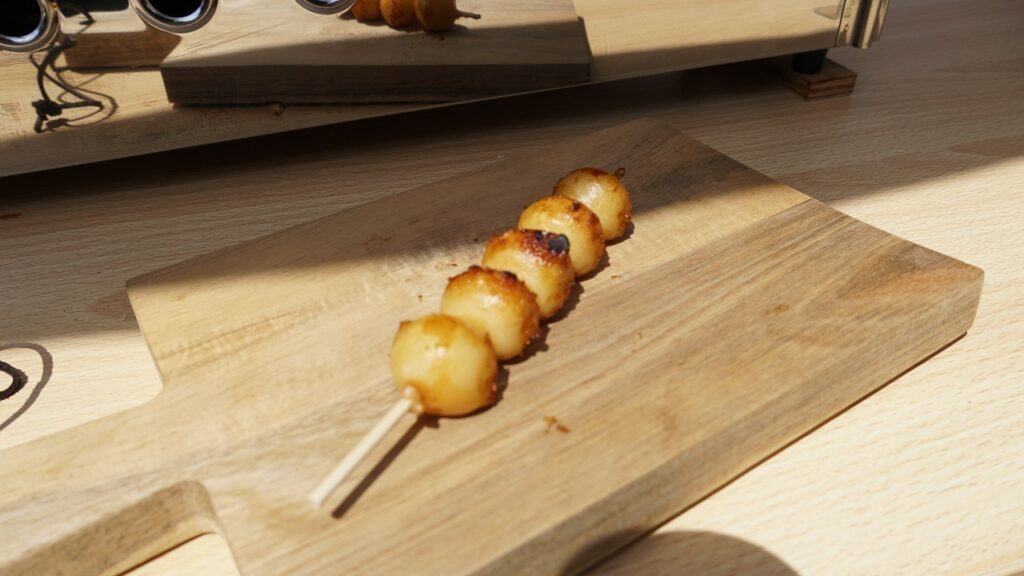
Mitarashi Dango on a street stall in Takayama
Ahh, the Hida beef. It was in Takayama that I fell head over heels with Hida Beef. Seriously, if you eat meat you HAVE GOT to taste this one. It simply melts in your mouth, and I can safely say it was one of the best I had in my life. Hida Beef is a type of Wagyu, raised in the Gifu Prefecture (for a bigger picture, Japan is subdivided into 47 prefectures) and they say the region’s pure water makes the cattle healthier and the meat, tastier.
The best ways to taste Hida Beef is by eating Sirloin Steak, the traditional Sukiyaki (a hot pot with thinly sliced meats, vegetables, tofu and soy sauce), Yakiniku (a type of Japanese barbecue where you usually prepare your own meat on a grill right on the table), or eating the unusual Hida Beef Sushi.
The only con is that eating Wagyu, even in Japan, doesn’t come cheap. But I assure you, it’s worth trying at least one meal. At Takayama, we have 4 restaurant recommendations, from which we went to two of them. Check out our experiences and the prices below:
Maruaki Takayama Restaurant
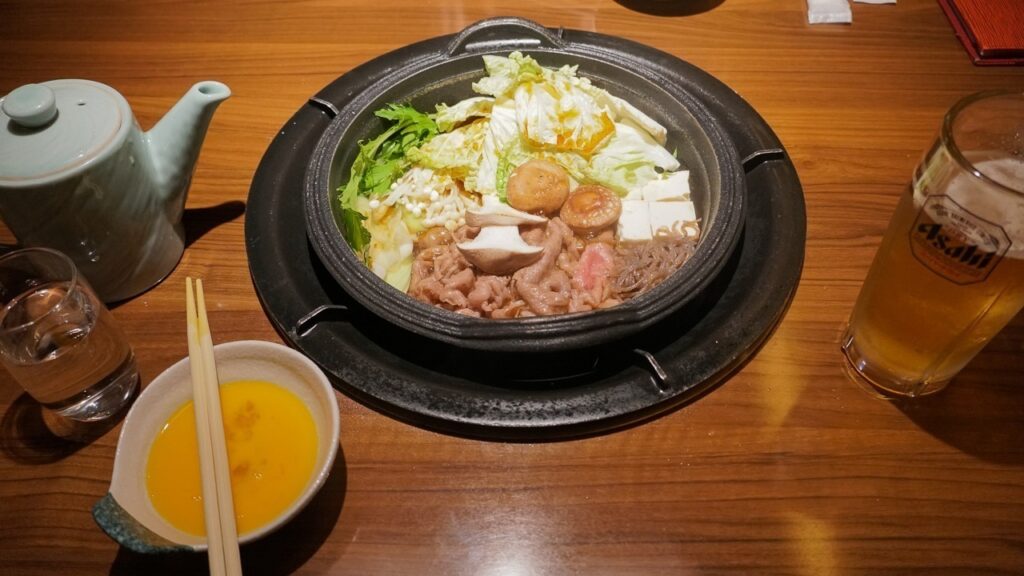
Sukiyaki at the Maruaki restaurant in Takayama. Note that the grill and fire are embedded in the table!
At Maruaki we tasted a Hida Beef Sukiyaki that was simply heavenly. The Sukiyaki was prepared on the table right in front of us. First a piece of fat was put in the pan, then the meats, the vegetables, and finally the broth. In a separate pot, you break an egg and whisk it, and this is where you’ll dip the meat after removing it from the pan. This is a way for you not to burn your mouth because the meat comes out very hot, and also serves as if it were an extra sauce. But I confess that I often ate the meat straight out of the pot, without the egg, so good it was. At Muruaki you can also order several other dishes such as sirloin, yakiniki, and even sushi.
Total bill for two people (with beer): ¥9350 (approx. USD 85).
Hida Takuma Restaurant
We were in Takayama on a Tuesday, and I had no idea that the vast majority of restaurants closed right on Tuesday. We ended up at Hida Takuma by chance and luck, as we were about to starve and it was almost 10 pm (and this is the Takayama equivalent of like 3 am, when almost everything is closed altogether or closing). We saw it open, went in and had a great experience overall.
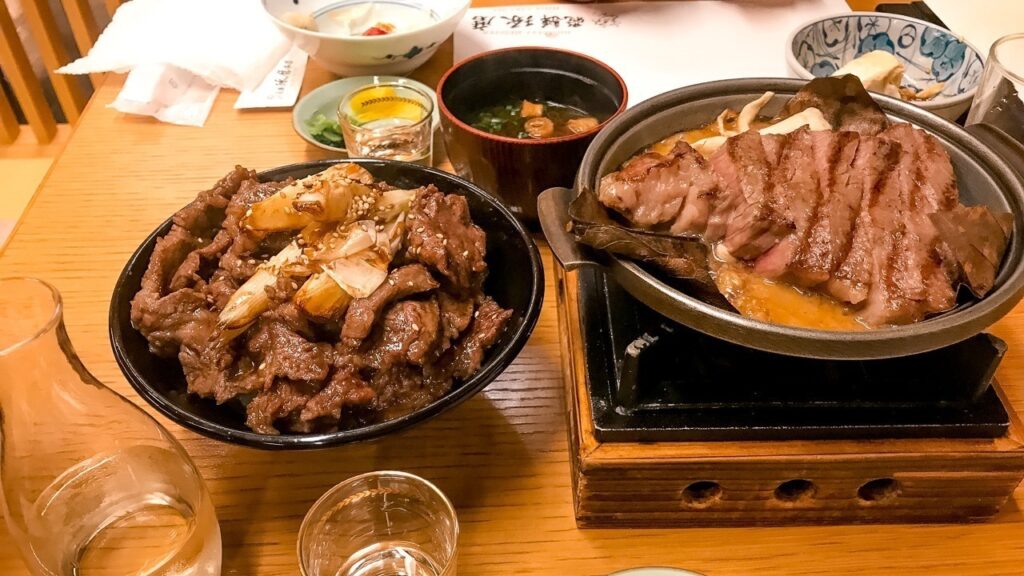
Beef bowl and Hida Beef, service with rice and miso soup.
The environment was beautiful and the owner was super friendly; he chatted with us and even gave us a small bottle of Martini Brut when he found out it was our honeymoon. To eat, I ordered a menu with Hida Beef steak which was wonderful again, and Cleber ordered a beef bowl with meat that wasn’t Hida, and it wasn´t as good — the difference was noticeable. I didn’t find the prices very friendly either, but it was a good option and the Hida was divine as always!
Total bill for two people (with sake): ¥10800 (approx. USD 100)
Other recommendations of where to eat in Takayama
As I’ve said before, we were in Takayama on a Tuesday and the Kyoya restaurant, which was the recommendation of our hotel concierge, was closed. We saw several good recommendations, but we’ll get to them the next time. In that same fateful Tuesday, we tried to go to Hidagyu Maruaki, which is one of the most famous in town for Hida Beef and slightly more gourmet too. However, the restaurant closed at 9 pm and the last order could only be placed at 8:30 pm. We arrived at 8:15 pm and they no longer served us… but here’s the tip anyway, because it’s a good one! Finally, Heianraku is a very popular Chinese restaurant in the city. The ramens are also famous around here and great for warming up and surviving the cold of the region.
Things to do in Takayama
Historic center
The old city center of Takayama is called Takayama Sanmachi Suji and is, in my opinion, the coolest tour in the city. It’s basically 3 streets with buildings from the Edo period (dating from over 200 years ago), and you really feel like you’re in a city that stopped in time when you walk around there. Like, you know the Japan from our imagination? It pops up all the time in Takayama.
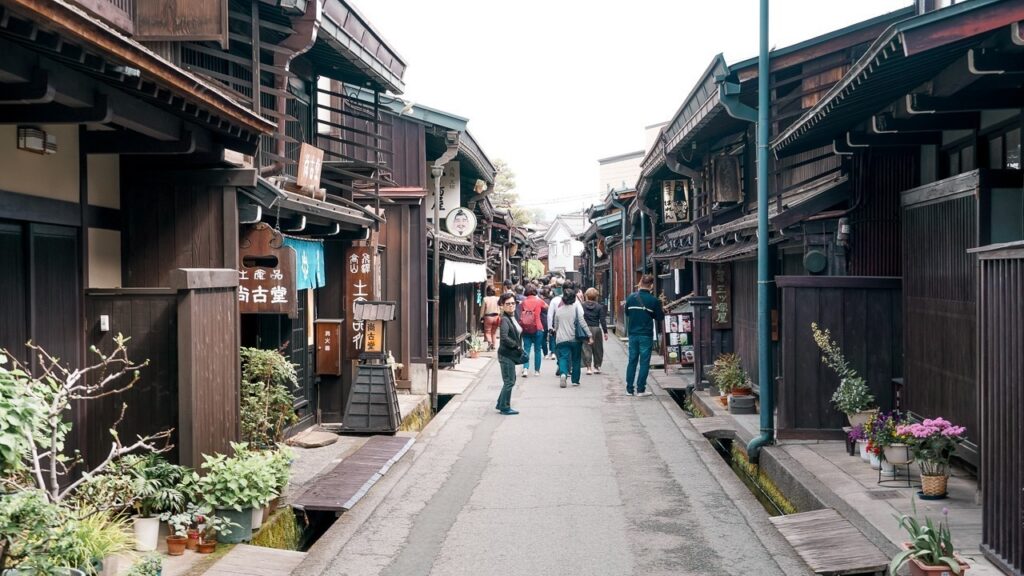
What to do in Takayama? Get lost in the narrow streets of the historic center!
Shopping
Some of these old downtown buildings house shops, grocery stores, and restaurants. Set aside some time and prepare your wallet because they’re all really good, packed with so many beautiful things and very well done. Some of them specialize in incense, others in chopsticks, others in porcelain, souvenirs and the coolest, there are many sake distilleries over there! And the best of all, you can do sake tasting for a really good price (around 100 or 200 yen, about 1 or 2 dollars).
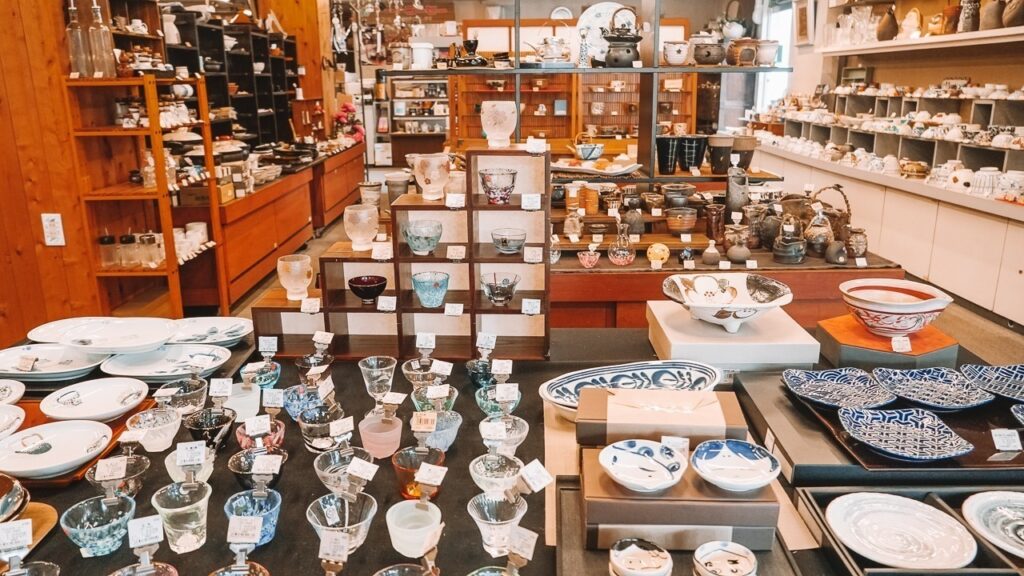
Shops everywhere. Takayama turned out to be a great destination to lose yourself in shopping.
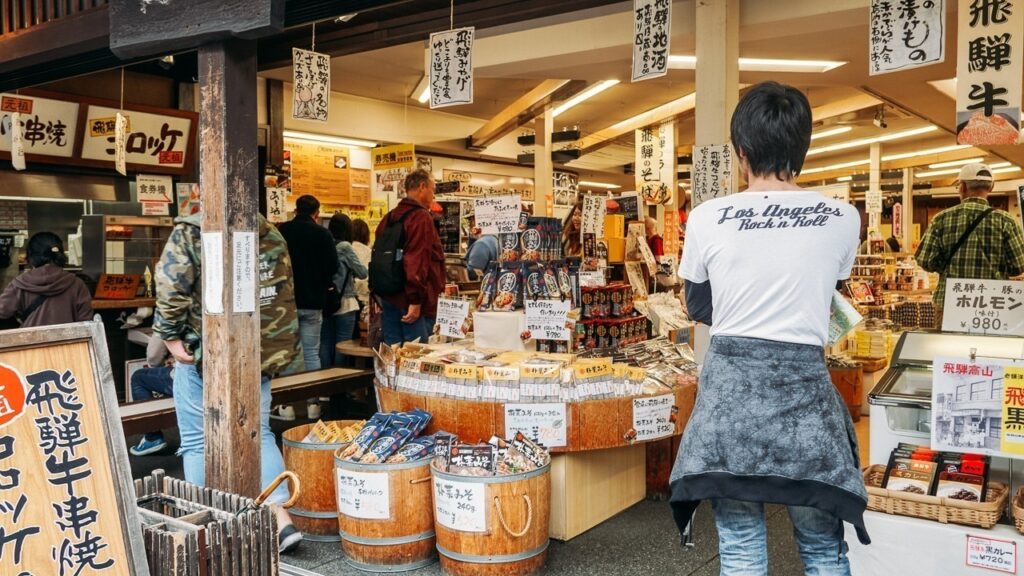
Grocery store: to taste all the snacks and different Japanese products.
Sake tastings and distilleries
The Hida region, where Takayama is, is famous for sake production because there are 3 elements that make the quality of their sake even better: the cold weather, the pure alpine water, and the rice. So, make use of your tour of Takayama and stop at one of the city’s 6 sake distilleries for a tasting: Hirata, Harada (the most famous ones), Hirase (the oldest), Kawajiri, Niki and Funasaka (the most inventive).
It’s easy to spot them, just look for a cedar ball above the doors and spot the sake barrels at the entrance outside. If the cedar ball is brown it’s a sign that the sake is ready for consumption, and if it’s green it indicated the sake has just been made. Those traveling during late January and February have the opportunity to take a tour and see how the beverage is made!
Heritage Houses
Besides the commerce, some of the buildings have remained as they used to be and are open for general public visitation, the so-called Heritage Houses. We visited the Yoshijima Heritage House, a house which belonged to a wealthy merchant who lent money and produced sake. Admission costs 500 yen (less than USD 5), and don’t be alarmed if the place looks closed from the outside. If you’re going within opening hours, go ahead and make yourself at home as there’ll be someone inside (at least that’s what happened to us).
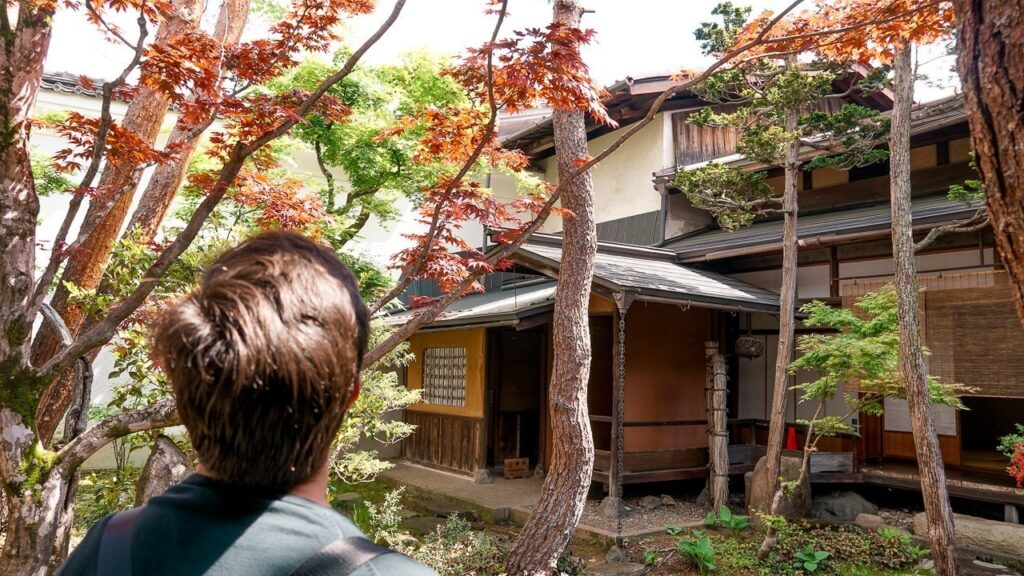
Garden inside the Yoshijima Heritage House
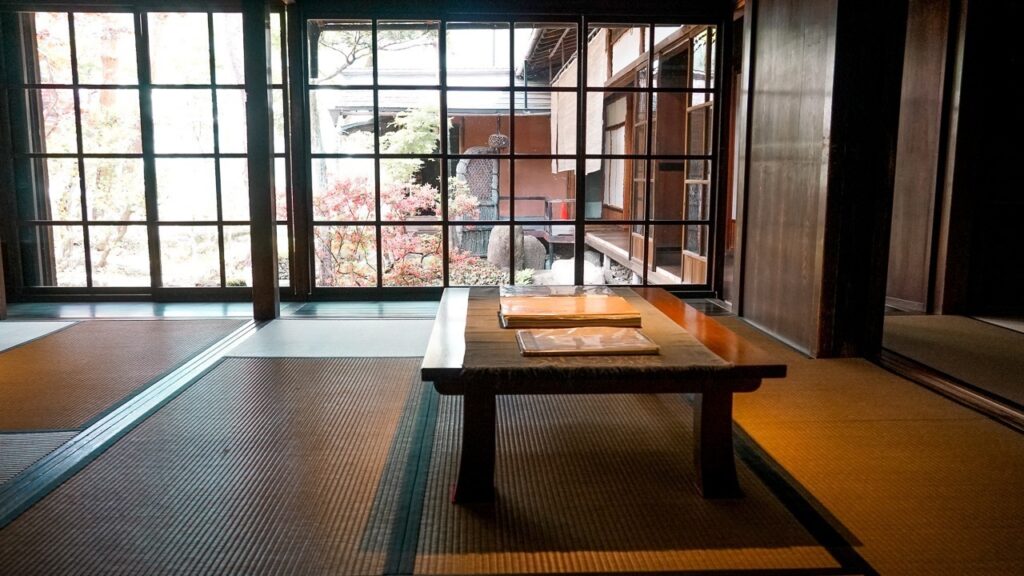
Still at Yoshijima Heritage House, in Takayama
Sakurayama Hachimangu Shrine and Takayama Yatai Kaikan
Not far from Yoshijima Heritage House is the Sakurayama Hachimangu Shrine, which is worth a quick visit and is free of charge. Make the most of your time here and head to Takayama Yatai Kaikan, a large shed where the Yatai (floats) are displayed, which are the famous allegories used during the Takayama Festival in the spring and fall. They are considered by UNESCO as an Intangible Cultural Heritage of Humanity. I didn’t enter as I was in a hurry and regret it… =/
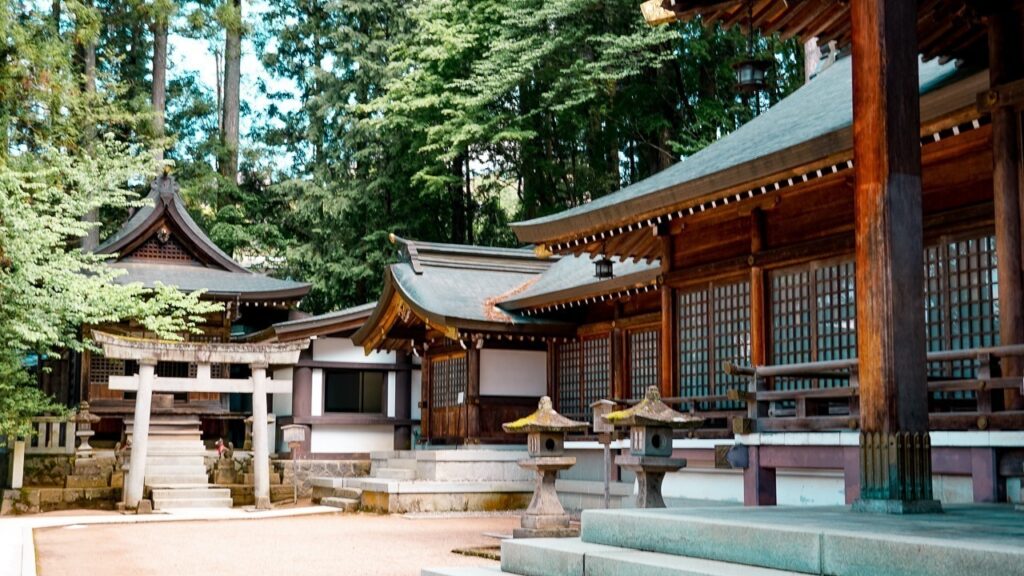
Sakurayama Hachimangu Shrine in Takayama
Jinya Takayama
Jinya Takayama is a complex that served as the headquarters for the first government of the Edo period. It’s a mansion with a Japanese garden in the background. It’s located near the iconic red bridge of Takayama, and a morning market takes place in front of the entrance of the building.
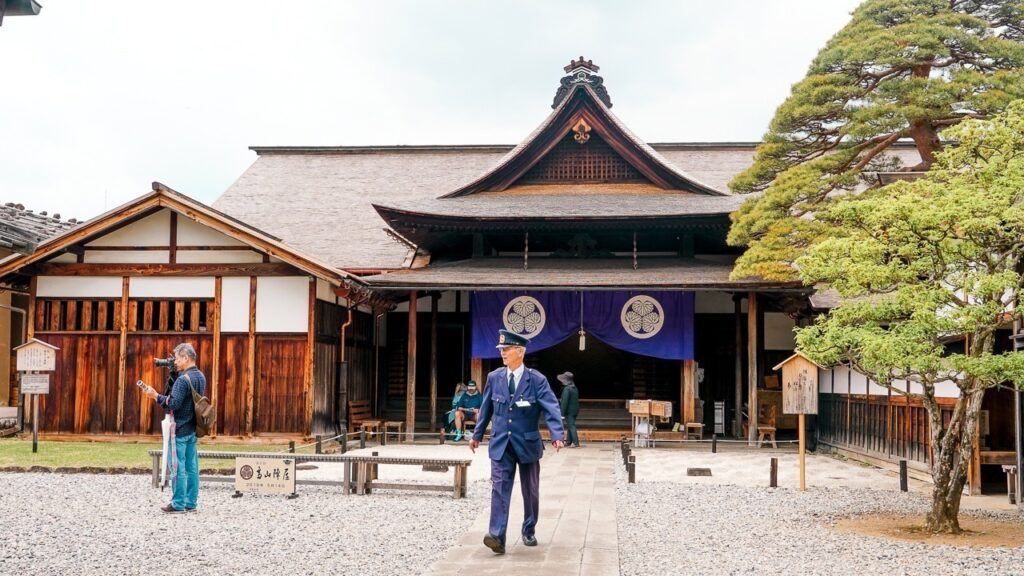
Jinya Takayama, the former seat of government.
Nakahashi – the red bridge of Takayama
I couldn’t fail to mention this lovely bridge that I saw really close to the Jinya Takayama. After all, it was bright red and got even more bucolic since the river bank was beautifully lined with traditional houses and super green vegetation. To get even better, there was a lonely cherry tree that decided to bloom a little later just to give us this experience! I found this view so Japanes.
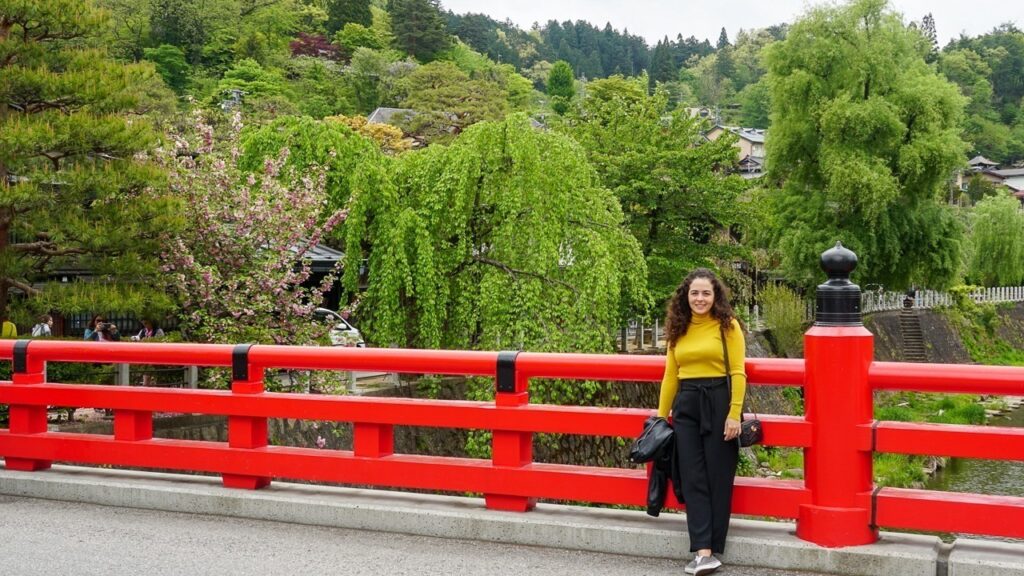
A lone cherry tree we saw in mid-May in Takayama. The region was the coldest of our trip.
Day trip to Shirakawa-go village
Besides all the tours in Takayama, the day trip to the historic village of Shirakawa-go is a must, in my opinion. The trip there is done by bus, and each stretch takes 1 hour and costs ¥2300 (or $20 as of May 2019). Some tourists choose to go from Takayama to Shirakawa, spend the day there, and then travel by bus to Kanazawa.
The village is a UNESCO World Heritage Site and is famous for the Gassho-Zukuri cottages, which have been around since 1700 and are preserved to this day. Fun fact: Gassho-Zukuri means “hands together in prayer” and refers to the thatched roof of the houses! It’s possible to visit the inside of them for about 500 yen (around $4 or so).
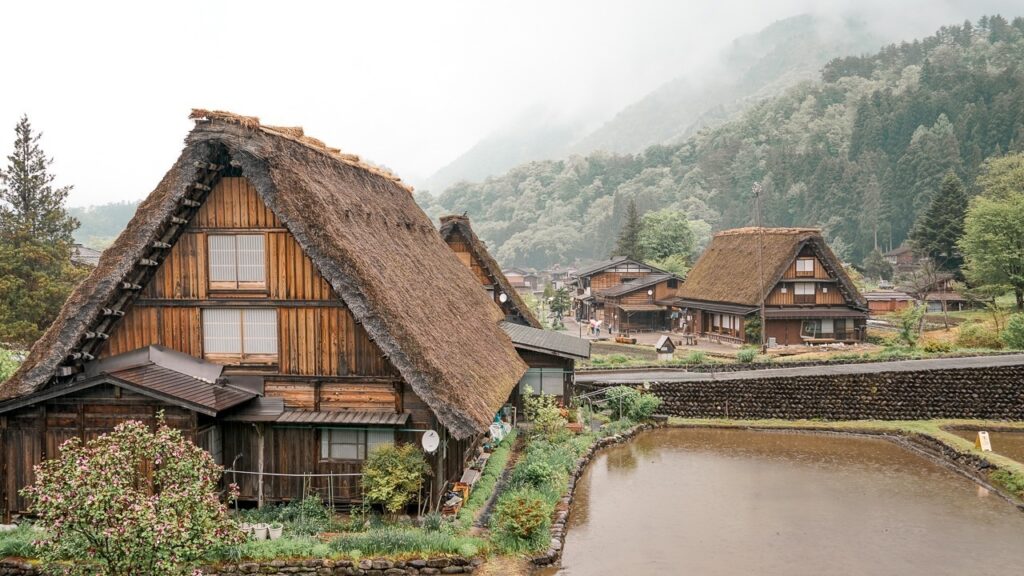
Shirakawa-go and the Gassho-Zukuri houses
Read more: The 5 most impressive temples I visited in Japan
Our two-day itinerary in Takayama
I’ll try to summarize here (a difficult task) how was our itinerary in Takayama for these two nights we spent there:
Day 1 – arrival at Takayama and setting in
First off, we went to our hotel Takayama Ouan to drop off our bags and take a quick shower before leaving. Soon afterward we went downtown; it was almost 4 pm so we had a short time before everything closed. So we took the opportunity to go to some shops and grocery stores, and we swang by the sake distilleries to taste some brews. But we were really hungry and went to Muruaki restaurant to eat Sukiyaki.
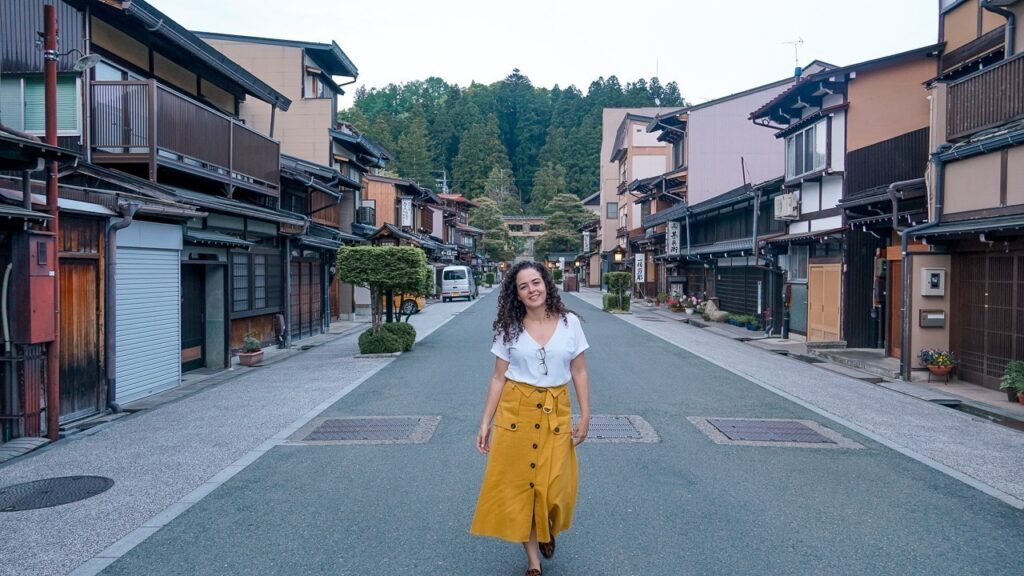
When we left, around 6 pm, the city was starting to get a lot calmer (read: really dead). Even so, we walked around aimlessly and without a predefined itinerary. We strolled by the river, near a giant torii around there, and wandered the streets of the historic center. We took the opportunity to book our bus tickets to Shirakawa-go the next day. We entered a few small shops that were still open, like a stationery shop and a souvenir shop, and we passed by some shrines along the way. It was an afternoon to settle in and get to know the city. I don’t know how in the world we were still hungry, but we stopped to share a pizza and a beer in the Salute restaurant on the way to our hotel. At that point, it would’ve been ideal to have gone to the hotel rooftop onsen, but we were both very amateur… we watched the Game of Thrones season finale, instead.
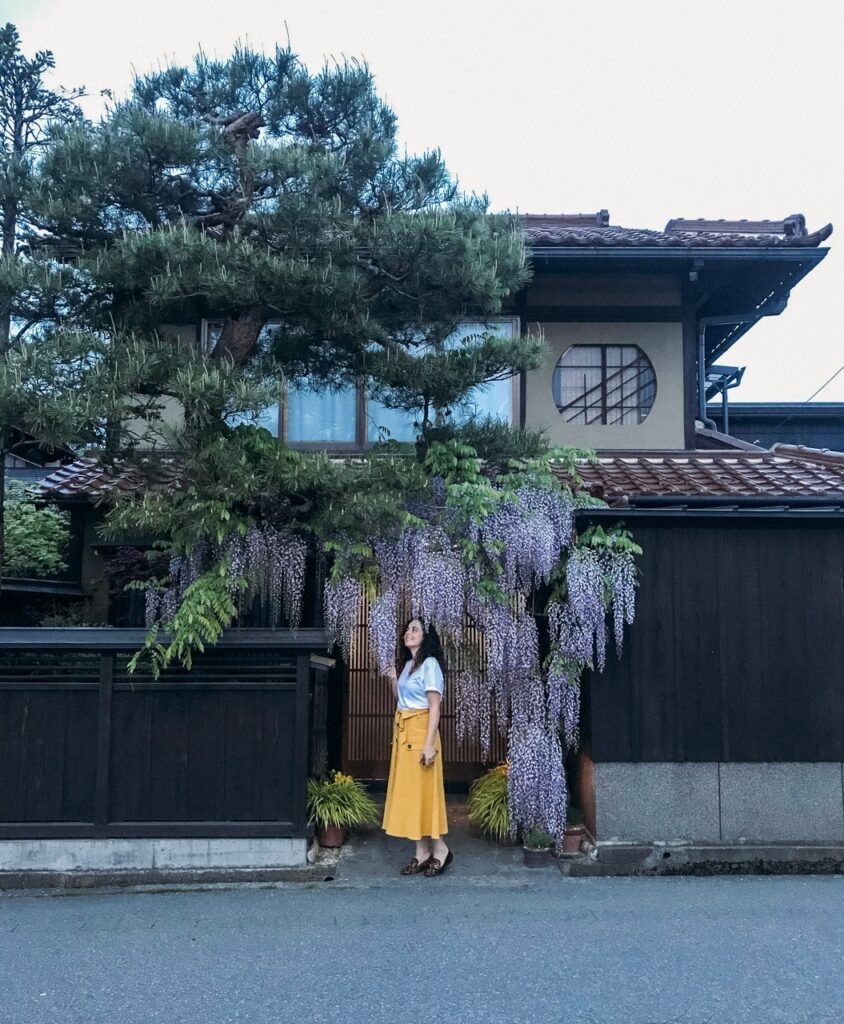
Imagine if the owner of this house opens the door and catches me doing this stupid pose? Lol
Day 2 – Full day in Shirakawa-go and Takayama
The next day dawned much colder. We had breakfast and I spent quite some time at the front desk asking to change rooms. Let me explain: for the same room category (standard) and the same price there were two different room sizes. I was shocked and wouldn’t get over it. With poor English and a little difficulty, the receptionist changed our room.
After this slight inconvenience, we went for a walk in the center, now with the shops running full steam. We started at a market near Jinya Takayama and the red bridge. We walked downtown to look at the shops, but soon afterward it was time to take the bus to Shirakawa-go, where we had lunch and strolled around until about 5 pm (when the city was already quite empty).

These are miniature tea sets! Use the necklaces hanging on the wall as a reference and notice hoy tiny they really were.
We went back to Takayama and headed straight for the hotel rooftop onsen to watch the nightfall. AN ABSOLUTE DELIGHT! I could have stayed there all night, and I began to wonder why every hotel in the world doesn’t have that. After an intense and cold day, getting into the warm onsen was super relaxing! We then realized how late it was and we had the difficult task of finding a restaurant for dinner. We found the Hida Takuma and ended the night with a bottle of sake and Hida Beef.
Day 3 – Farewell from Takayama and departure to Kanazawa
We woke up early because we still wanted to visit the Heritage Houses. We went to Yoshijima, and from there we went to Sakurayama Hachimangu Shrine. As I said, I slightly regret that I didn’t go into the Takayama Yatai Kaikan, but instead I walked with no rush back to the hotel and passed by the riverfront market.
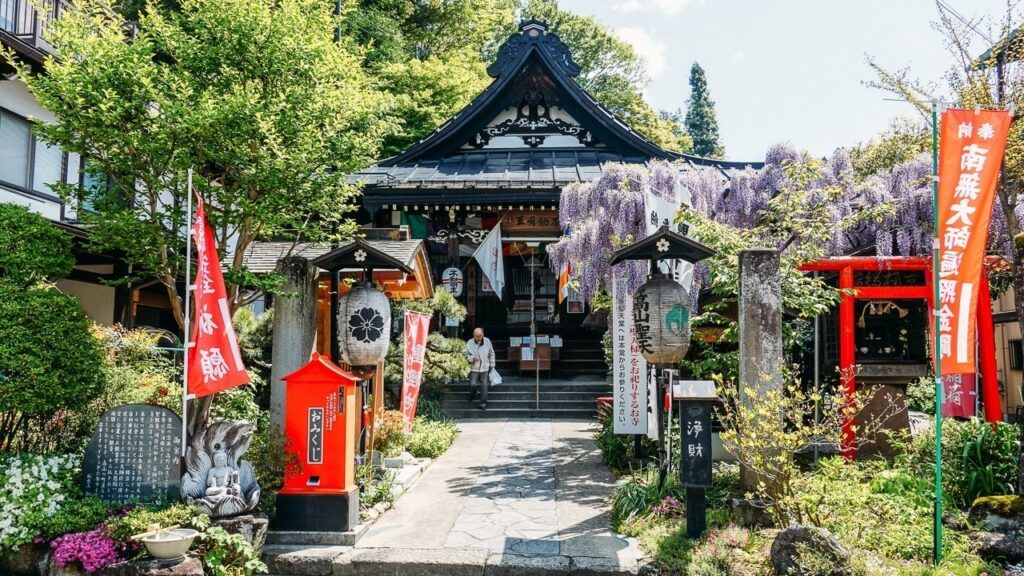
The beautiful surprises on the way back, to end the visit to Takayama.
We picked up our luggage at the hotel, which was right by the station, and got on the train to Kanazawa. We left with the desire to return again, perhaps in April to be able to see the cherry-filled city by the river, while the Takayama Matsuri floats are happily carried through the city streets. ♥






Deixe seu comentário